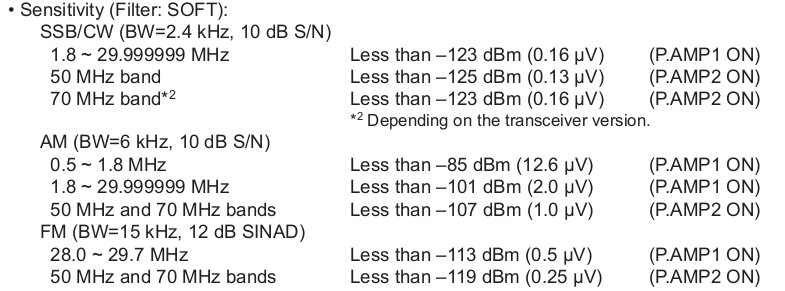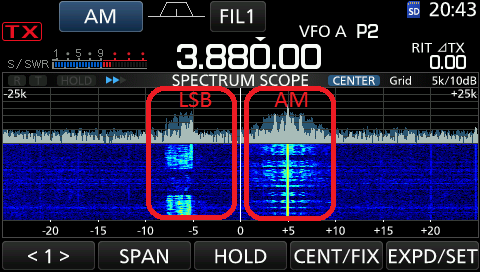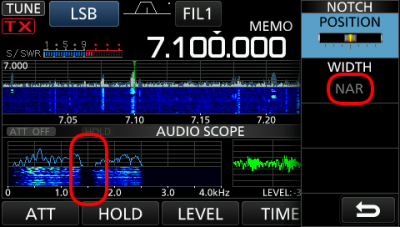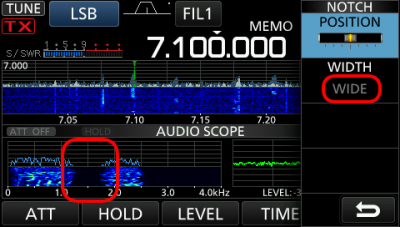This is an old revision of the document!
Table of Contents
Under Construction: VA7FI is editing this section, please do not edit it until this notice is taken down.
Recall
Receivers
There are three main characteristics of a receiver: sensitivity, selectivity, and stability.
Sensitivity
A signal is always accompanied by some sort of noise, and very roughly speaking, if the signal is stronger than the noise, then it can be heard. To quantify this, we use a term called Signal-to-Noise Ratio (SNR or S/N):
\$$\text{SNR} = \frac{\text{Signal}}{\text{Noise}}\$$
Since SNR is a ratio:
- If SNR > 1, then the signal is stronger than the noise.
- If SNR = 1, then the signal and the noise have the same strength.
- If SNR < 1, then the noise is stronger than the signal.
Like other ratios, we often express SNR in decibel. Recall that a ratio of 1 = 0 dB, so the above could be stated as:
- If SNR > 0 dB, then the signal is stronger than the noise.
- If SNR = 0 dB, then the signal and the noise have the same strength.
- If SNR < 0 dB, then the noise is stronger than the signal.
Now back to the receiver. The sensitivity of a receiver is its ability to pick out weak signals from the noise. That is, it indicates how faint an input signal can be and still be successfully received by the receiver.
For example, here's the specs sheet from the IC-7300:
For example, a receiver with a sensitivity of -123 dBm can pick out a signal of 0.0000000000005 mW.1)
Selectivity
Recall from the intro section that radio signals always take up some bandwidth on the radio spectrum:
- CW takes the least amount of “space” because it's essentially just a single note being turned on and off. A 250 Hz filter would work well to isolate the signal and reject neighbouring signals.
- RTTY is a digital mode that uses two notes to represent 0s and 1s, thus it takes a little bit more space than CW.
- SSB signals usually have a bandwidth between 2 kHz and 3 kHz. A 2.4 kHz filter would work well to isolate the signal and reject neighbouring signals.
- FM, needs about 20 kHz, which is why FM radio stations sound better than AM radio stations.
Now back to the receiver. The selectivity of a receiver is its ability to pass only the signal of interest and reject everything else.
Filters
Sometimes a specific noise or interference is mixed in the signal and we'd like to reduce or eliminate it. One way is to use filters. You can think of filters a little bit like the equalizer on a Hi-Fi stereo.
- A filter that lets high frequencies through but blocks low frequencies is called a high pass filter.
- A filter that lets low frequencies through but blocks high frequencies is called a low pass filter.
- Combining a high pass and low pass filter we get a band pass filter, which lets audio between two frequencies. The narrower the bandwidth of the mode we use, the narrower the band pass filter we can use to clean up the audio. For example:
- An SSB voice signal can use a 2.4 kHz filter where as
- A CW signal can use a much narrower 250 Hz filter.
- The “inverse” of a band pass filter is called a notch filter. It blocks a narrow band of frequencies in the middle of the audio spectrum. Here's an example:
This picture has three main parts. From top to bottom:
- The frequency is 7.100 MHz on LSB.
- The scope shows this frequency relative to the entire band (7.000 Mhz to 7.300 Mhz)
- At the bottom is the audio spectrum of what we hear (with a 2.4 kHz band pass filter).
You'll notice that there's a very intense line around 1.5 kHz on the audio spectrum. This line, coming from an interfering carrier signal, sounds like a loud note (a little above \$ \text{F}_{6}^{\text{#}} \$ for the musicians out there) mixed with the voice. To remove this tone, we can “notch” it. We now see a dark spot around 1.5 kHz. If we need to, we can make this spot more or less wide.
Stability
This is the ability of a receiver to stay on the right frequency and not drift.







